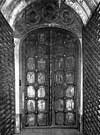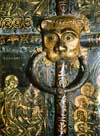| Виртуальный Владимир » Город Владимир » Old Russian Towns » Suzdal » Historic buildings » Cathedral of the Nativity » Golden Gates |
 ...
... frescoes
frescoes Golden Gates
Golden Gates later alterations
later alterations
 A striking example of it can be found in the magnificent "golden gates" which adorn the cathedral's south and west portals to this very day, real masterpieces of thirteenth-century Russian applied art. The huge doors are divided into rectangular panels by raised rolls. The rich decoration and many small scenes on the panels are executed in a complicated technique of fusing gold on to a dark, velvety background of bronze, against which the gold designs shine out beautifully. The door handles were shaped in the form of lions' heads with massive rings in their jaws. The gates were like a huge gold icon gleaming in the carved frame of the portal.
A striking example of it can be found in the magnificent "golden gates" which adorn the cathedral's south and west portals to this very day, real masterpieces of thirteenth-century Russian applied art. The huge doors are divided into rectangular panels by raised rolls. The rich decoration and many small scenes on the panels are executed in a complicated technique of fusing gold on to a dark, velvety background of bronze, against which the gold designs shine out beautifully. The door handles were shaped in the form of lions' heads with massive rings in their jaws. The gates were like a huge gold icon gleaming in the carved frame of the portal.
The west gates were adorned with scenes from the Gospels, pride of place being given to the Virgin Mary who was regarded as the patron of the Vladimir lands. Here we find one of the earliest portrayals of the festival of the Intercession which was instituted by the Vladimir church authorities. The lower panels are covered with the figures of lions and griffins surrounded by intricate foliate patterns very similar to the stone animal carvings of the Vladimir-Suzdalian school.
 The figures of saints in medallions include St. Mitro-phanes, the patron saint of Mitrofanes, bishop of Suzdal from 1227-1238, who commissioned the west gates and was later among those burnt to death by the Mongols in the Cathedral of the Assumption in Vladimir.
The figures of saints in medallions include St. Mitro-phanes, the patron saint of Mitrofanes, bishop of Suzdal from 1227-1238, who commissioned the west gates and was later among those burnt to death by the Mongols in the Cathedral of the Assumption in Vladimir.
 The main south gates are particularly interesting, containing pictures of saints after whom the Vladimir princes were named. It is likely that these gates were made during the years 1230 to 1233 by order of Vse-volod Ill's son, Prince Georgi. The main scenes show the acts of the angels, in particular the Archangel Michael, the powerful warrior saint who protected the princes in their military ventures. There are many exquisitely composed scenes on fascinating subjects, such as Jacob wrestling with the angel, and Daniel in the lions' den where the lions are very similar to those found in stone carvings. The picture of Adam being instructed by the Archangel Michael shows Adam digging with a wooden spade bound with strips of metal similar to twelfth-century spades found during excavations. The inscription on the panel even gives us the old Russian name for this type of spade, ryltse. Another interesting composition depicting the miracle of Christ turning the water into wine at Cana shows people standing on the top of cliffs using the same type of spade.
The main south gates are particularly interesting, containing pictures of saints after whom the Vladimir princes were named. It is likely that these gates were made during the years 1230 to 1233 by order of Vse-volod Ill's son, Prince Georgi. The main scenes show the acts of the angels, in particular the Archangel Michael, the powerful warrior saint who protected the princes in their military ventures. There are many exquisitely composed scenes on fascinating subjects, such as Jacob wrestling with the angel, and Daniel in the lions' den where the lions are very similar to those found in stone carvings. The picture of Adam being instructed by the Archangel Michael shows Adam digging with a wooden spade bound with strips of metal similar to twelfth-century spades found during excavations. The inscription on the panel even gives us the old Russian name for this type of spade, ryltse. Another interesting composition depicting the miracle of Christ turning the water into wine at Cana shows people standing on the top of cliffs using the same type of spade.
The panels on both gates showing Gospel scenes, the Virgin Mary and the angels, the Creation and figures from the Old Testament are all provided with clear, brief inscriptions and unfold before one's eyes like the pages of an exquisitely illustrated manuscript. These inscriptions provide valuable material for the study of the old Russian language and orthography.
According to a cathedral inventory dated 1609 the same damascene technique was used on the bishop's ambo, a pulpit which stood slightly elevated in front of the Holy Doors in the altar screen. Its sides were decorated with feasts of Our Lord and the Virgin Mary. This splendid object evidently disappeared when Suzdal was sacked by the Polish invaders.
The golden gates are a magnificent example of Vladimir-Suzdalian craftsmanship combining severe, laconic composition with a love of rich ornament. As we have already pointed out, this passion for ornament is a feature of popular art and reflects the artistic tastes of the ordinary people of the Vladimir lands who produced these gifted masters. The cathedral was also richly endowed with precious plate brought by merchants from distant lands.
Thus we have a picture of the cathedral in its original form.
Оставить комментарий:



 Виртуальный Владимир
Виртуальный Владимир Область
Область Панорамы города
Панорамы города Организации
Организации Улицы и дома
Улицы и дома Добавить организацию
Добавить организацию О городе
О городе










